
TRANSPORTATION AND THE U.S. SUPPLY CHAIN
As 2021 presses on, businesses “reopen” and we find ourselves returning to a sense of normalcy, the stressors on the supply chain continue. It’s no secret that the major shifts felt across supply chains over the last 12-18 months have revealed major flaws in manufacturing and distribution networks, worldwide.
Here in the U.S. our primary means of distributing goods across the nation are via road and rail. Much like other industries, driver and transportation shortages continue to plague a return to normalcy, interrupting what American Trucking Associations President and CEO Chris Spear, refers to as “the Linchpin of the U.S. Supply Chain.”
Shortages aren’t the only roadblock facing freight industries. Organizations like the American Trucking Association are calling for bipartisan action to help strengthen and ensure the longevity of America’s supply lines with specific focus on things like:
- Infrastructure
- Workforce
- Safety and the Environment
- And several specific Legislative Steps
The Trucking Industry and the U.S. Supply Chain
While our nation’s supply chain and transportation system has a myriad of parts, the trucking industry makes up a significant portion of the freight network.
In 2017, trucking was a $700 Billion industry, with over-the-road trucking providing transport of over $10.4 Trillion of goods that represented more than half of the U.S. GDP. Experts say that over the next 10 years, trucks will be tasked with moving 2.4 billion more tons of freight than they do today.
As the need for freight capacity increases, the demands on related aspects of the network will increase as well, including additional drivers, warehouse and storage space, infrastructure improvements, and more.
Building Resilient Freight Networks
Creating better supply chains isn’t just about managing freight flow, maintaining infrastructure and increasing workforces. 3PL providers should be actively working to create resilient freight networks, focused on finding niche partners that have the capacity to serve specific needs of retailers, and movers of goods and product.
Our focus on creating solutions for trouble lanes has allowed us to create a network of shippers that are capable of filling lanes, longterm. Providing consistency across supply chain networks and reducing delays in some of the final legs of the product delivery process. As the nation’s transportation network continues to churn at maximum capacity to keep up with growing consumer demand and transportation needs, Paystar Logistics looks to push forward in continuously improving our active sourcing process as we match the unique needs of our clients with the carriers who are best positioned to fill their lanes.
MORE ARTICLES

Spear Phishing in the Transportation Sector: What is it and How to Protect Yourself
While the transportation and logistics industry isn’t new to experiencing coordinated “cyber attacks”, cybercriminals are constantly iterating on their methods of infiltration. Just this year, several top IT firms have identified a sharp increase in costly security breaches that all follow a similar pattern. In this pattern, the primary attack vector is a method known…

Why We’re Committed to the SmartWay program
Paystar Logistics is proud to announce our recent designation as a SmartWay High Performer. As a SmartWay Partner, we join the EPA in their quest to build a more efficient, productive, and sustainable freight industry.

A Look at the U.S. Truck Driver Shortage in 2021
A truck driver shortage is nothing new to the U.S. In fact, according to a 2019 analysis report by the ATA (American Trucking Association), we have struggled with truck driver shortages for the past 17 years. This was first recognized in 2005 when we were short, roughly 20,000 drivers to fulfill shipping demands. However, by the end of 2018, that number rose to…

